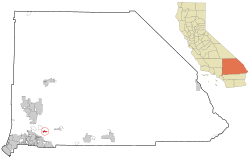Running Springs, California facts for kids
Quick facts for kids
Running Springs
|
|
|---|---|

Location in San Bernardino County and the state of California
|
|
| Country | |
| State | |
| County | San Bernardino |
| Area | |
| • Total | 4.213 sq mi (10.912 km2) |
| • Land | 4.204 sq mi (10.889 km2) |
| • Water | 0.009 sq mi (0.023 km2) 0.21% |
| Elevation | 6,109 ft (1,862 m) |
| Population
(2020)
|
|
| • Total | 5,268 |
| • Density | 1,253.1/sq mi (483.8/km2) |
| Demonym(s) | Running Springser |
| Time zone | UTC-8 (PST) |
| • Summer (DST) | UTC-7 (PDT) |
| ZIP code |
92382
|
| Area code(s) | 909 |
| FIPS code | 06-63316 |
| GNIS feature ID | 1661346 |
Running Springs is a small mountain community in San Bernardino County, California, United States. It's known as a census-designated place (CDP), which means it's a community that looks like a town but isn't officially governed by its own city government. In 2020, about 5,268 people lived here.
Running Springs is located in the beautiful San Bernardino Mountains. It's home to the huge 3,400-acre National Children’s Forest, a special place for learning about nature. Also, Snow Valley Mountain Resort, one of the first ski resorts in these mountains, started here in the 1920s.
Contents
Exploring the History of Running Springs
The very first people to live in this area were the Serrano people. They called themselves Yuhaviatam, which means "people of the pines." A Spanish priest named Father Garces gave them the name "Serrano," meaning "mountain people," in 1776.
Ancient Life of the Serrano People
The Serrano people settled here because of the many natural resources. They found lots of acorns and herbs. They also hunted animals like deer and rabbits. You can still see many "mortar holes" in the area. These are holes in rocks where the Serranos would grind acorns into meal.
How Running Springs Got Its Name
Running Springs was first called Hunsaker Flats. This name came from Abraham Hunsaker, who was an early member of a group called the Mormon Battalion. The area began to grow and develop in the 1920s after the state highways were improved, making it easier to travel here.
Understanding Running Springs' Geography
Running Springs is located in the San Bernardino Mountains. It sits at coordinates 34°12′28″N 117°6′30″W / 34.20778°N 117.10833°W.
Size and Landscape of the Community
The community covers about 4.2 square miles (10.9 square kilometers). Most of this area, about 99.79%, is land. A very small part, 0.21%, is water.
Population and People of Running Springs
In 2010, the population of Running Springs was 4,862 people. By 2020, it had grown to 5,268 people.
Diversity in Running Springs
According to the 2010 census, most residents, about 89.0%, were White. There were also smaller groups of African American, Native American, Asian, and Pacific Islander residents. About 14.3% of the people identified as Hispanic or Latino.
Homes and Families in the Community
In 2010, there were 1,944 households in Running Springs. About 31.4% of these households had children under 18 living in them. Most households, 52.8%, were married couples living together. The average household had 2.50 people.
Economy and Surroundings of Running Springs
Running Springs is a mountain community located within the San Bernardino National Forest. It's a key entry point to other mountain towns like Lake Arrowhead and Big Bear. It's also the closest community to Snow Valley Mountain Resort.
Local Economy and Tourism
Running Springs doesn't have one main industry. Instead, its economy is based on services for tourists. The San Bernardino National Forest attracts visitors all year round, which helps local businesses. Many people who live in Running Springs also work in nearby San Bernardino, making it a "bedroom community."
The Rim of the World Area
Running Springs is part of an area called the "Rim of the World." This is a stretch of inhabited land in the San Bernardino Mountains that goes from Crestline to Big Bear, covering about 30 miles. Students from Running Springs attend Rim of the World High School in Lake Arrowhead.
History of Logging in the Mountains
Long ago, logging was a big industry in the San Bernardino Mountains. The Brookings Lumber Company was the largest, operating from 1899 to 1912. They used a special logging railroad to move logs to their sawmill. The logs were then sent down the mountain by wagon to make packing crates for citrus fruits.
Running Springs in Movies and Culture
Running Springs has been a filming location for several movies. Film producer David O. Selznick lived here and used nearby Big Bear Lake for scenes in his famous 1939 film Gone With the Wind.
Movies Filmed in Running Springs
Some of the movies filmed in or around Running Springs include:
- Next (2007)
- When a Stranger Calls (2006)
- Communion (1989)
- Small Town Saturday Night (2010)
- I'm Reed Fish (2006)
- Messenger of Death (1988)
- Demon Legacy (2014)
- The Bigfoot Project (2017)
- Cold Cabin (2010)
There was even a film simply titled Running Springs that was set and filmed in the area.
Sister Cities
Running Springs has a sister city relationship with:
Images for kids
See also
 In Spanish: Running Springs para niños
In Spanish: Running Springs para niños



